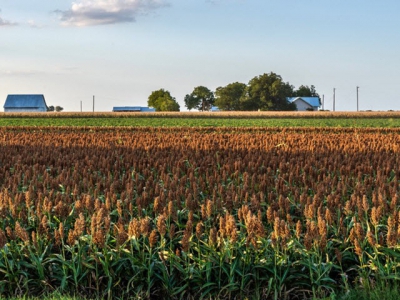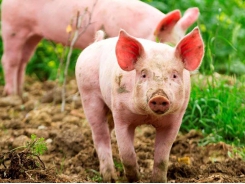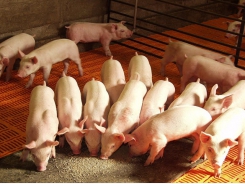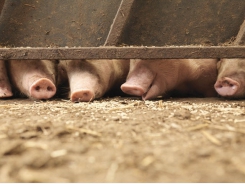Mexico: Evaluating sorghum varieties for use in pig rations

Mexican researchers looked at the impact of kafirins and tannins concentrations in sorghum on the ileal digestibility of amino acids and starch, and on the glucose and plasma urea nitrogen levels in growing pigs.
They noted that kafirins in low-tannin sorghum diets did not negatively impact nutrient utilization.
In the first feeding experiment, researchers found that starch digestibility was not altered by the levels of kafirins or tannins in the sorghum. However, kafirin levels reduced the AID of glutamic acid and histidine and tended to lower the apparent ileal digestibility (AID) of alanine, aspartic acid and valine along with the SID of alanine, glutamic acid, valine and histidine.
Increased amounts of tannins negatively altered the AID of dry matter, lysine, cysteine, histidine, methionine, energy, crude protein, aspartic acid, leucine and threonine, the researchers said. The feed element also reduced the standardized ileal digestibility (SID) of cystine, histidine, lysine, protein, aspartic acids, leucine, serine, threonine, methionine and valine digestibility.
The interaction of tannins and kafirins lowered the AID of glutamic acid and lysine, they added.
In the second feeding trial, kafirins were found to have a delayed effect on glycemia and tannin levels were linked to a decline in glycemia 150 and 360 minutes following consumption, the researchers said. Dietary kafirin did not alter PUN levels, but high tannin levels of tannins reduced plasma urea nitrogen (PUN).
“Overall, these results indicated that kafirins content is not a detrimental factor for the efficiency with which pigs utilize nutrients from diets comprised of low-tannins sorghums,” they said. “But tannins do decrease the efficiency with which pigs can utilize nutrients in diets comprised of high-tannins sorghums.”
Why evaluate the use of sorghum in swine diets?
Following wheat, rice, corn and barley, sorghum is the fifth most raised cereal grain globally, said the researchers. The grain is most commonly used in animal feed, forage production, biofuel, beer and, in some regions, a food source.
The grain is used as an energy source in feed as it has high levels of starch (70-80%), they said. But levels of tannins and kafirins, or reserve protein, can reduce its nutritional value by lowering the availability of its nutrients – both tannins and kafirins can alter the digestibility of starch and protein.
“Due to the high inclusion level in the diet (60–80%), sorghum can contribute both to the energy content as well as the amino acid (AAs) requirement of the diet,” they added.
Feeds with reduced digestibility are associated with a low glycemic index and increased nitrogen excretion in waste, the researchers said. That interaction could be linked to the way the metabolism uses dietary energy and amino acids.
The glycemic response also can alter swine feed intake, carcass quality and feed efficiency, they said. However, questions remain about the influence of sorghum-based kafirin and tannins in growing pig diets.
Feeding trials
In the feeding trials, sorghums with high low tannin levels, high tannin content, low kafirin amounts and high kafirins were used to generate four diets – low in kafirin and tannins (LT-LK), low in tannins, high in kafirins (LT-HK), high in tannins, low in kafirins (HT-LK) or high in both tannins and kafirins (HT-HK), the researchers said.
Diets also included canola oil, sucrose, salt along with mixed vitamins and minerals, they said.
In the first feeding trial, pigs were acclimated to the facility for three days and to the diet for 5 prior to the collection of ileal digesta samples, they said. Digesta was collected for multiple days for analysis.
The collected ileal digesta was assessed for fiber fractions, gross energy, levels of methionine, cystine, amino acid content, starch concentrations and the amylopectin to amylose ratio, they said.
In the second trial, pigs had five days to adjust to the feed before the start of blood sample collection, the researchers said. Blood samples were collected at 0, 15, 20, 45, 60, 90, 120, 150, 180, 240, 300 and 360 minutes following feeding.
Samples were checked for glucose and urea concentration, they said.
Results
Overall, kafirin and tannin levels did not alter the ileal digestibility of starch, amylose and amylopectin, the researchers said.
The findings show that kafirin amounts “marginally” alter the AID and SID of amino acids, they said. Adding, “In contrast, the negative impact of tannins was significant on the AID of DM, CP, energy, and AAs, as well the SID of AAs and CP from sorghum.”
However, higher levels of kafirin reduced the AID of glutamic acid and histidine, they said. It also tended to lower the AID of alanine, aspartic acid and valine.
“The AID of the nutrients decreased with greater tannin content,” they said. “The decrease was for the AID of the DM [dry matter], energy, and lysine; the AID of cystine, histidine, and methionine was affected; and the AID of CP [crude protein], aspartic acid, leucine, and threonine also decreased.”
“In addition, the AID of serine also showed a tendency, to decrease in response to tannins levels,” they added. In low-tannin sorghum diets, high kafirin levels lowered the AID of glutamic acid and lysine, but the HT-HK diet increased the AID of lysine.
Higher levels of dietary kafirin also tended to lower the SID of alanine, glutamic acid, histidine and valine, the researchers said. Increased tannin levels dropped the SID of amino acids, lysine, protein, aspartic acid, leucine, methionine, serine, threonine and valine along with tending to decrease the SID of arginine.
The SID of lysine fell in low-tannin, high-kafirin diets, but increased in high-tannin, high-kafirin diets, they added.
Kafirin level did not alter glucose response, they said. “Pigs fed sorghum with high kafirins content showed a tendency (P = 0.08) to have higher glucose response at 300 min postprandial,” they added.
But high kafirin levels in the feed did tend to lower plasma urea nitrogen levels, but the influence did not last, they added.
Tannin level also was found to not influence glucose other than at 300 minutes following feed intake, when pigs on a low-tannin diet had a higher glucose response, the researchers said.
Pigs on the high-tannin diets, however, had a sustained drop in PUN level, they said.
Source: Livestock Science
Authors: T. de Souza, I. Árres, E. Rodríguez, G. Mariscal-Landín
Có thể bạn quan tâm
Phần mềm

Phối trộn thức ăn chăn nuôi

Pha dung dịch thủy canh

Định mức cho tôm ăn

Phối trộn phân bón NPK

Xác định tỷ lệ tôm sống

Chuyển đổi đơn vị phân bón

Xác định công suất sục khí

Chuyển đổi đơn vị tôm

Tính diện tích nhà kính

Tính thể tích ao hồ




 New tool uses swine respiratory cells to study…
New tool uses swine respiratory cells to study…  No nutritional silver bullet for zinc oxide replacement…
No nutritional silver bullet for zinc oxide replacement…